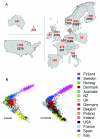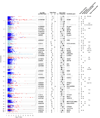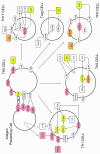Genetic risk and a primary role for cell-mediated immune mechanisms in multiple sclerosis
- PMID: 21833088
- PMCID: PMC3182531
- DOI: 10.1038/nature10251
Genetic risk and a primary role for cell-mediated immune mechanisms in multiple sclerosis
Abstract
Multiple sclerosis is a common disease of the central nervous system in which the interplay between inflammatory and neurodegenerative processes typically results in intermittent neurological disturbance followed by progressive accumulation of disability. Epidemiological studies have shown that genetic factors are primarily responsible for the substantially increased frequency of the disease seen in the relatives of affected individuals, and systematic attempts to identify linkage in multiplex families have confirmed that variation within the major histocompatibility complex (MHC) exerts the greatest individual effect on risk. Modestly powered genome-wide association studies (GWAS) have enabled more than 20 additional risk loci to be identified and have shown that multiple variants exerting modest individual effects have a key role in disease susceptibility. Most of the genetic architecture underlying susceptibility to the disease remains to be defined and is anticipated to require the analysis of sample sizes that are beyond the numbers currently available to individual research groups. In a collaborative GWAS involving 9,772 cases of European descent collected by 23 research groups working in 15 different countries, we have replicated almost all of the previously suggested associations and identified at least a further 29 novel susceptibility loci. Within the MHC we have refined the identity of the HLA-DRB1 risk alleles and confirmed that variation in the HLA-A gene underlies the independent protective effect attributable to the class I region. Immunologically relevant genes are significantly overrepresented among those mapping close to the identified loci and particularly implicate T-helper-cell differentiation in the pathogenesis of multiple sclerosis.
Figures




Comment in
-
Multiple sclerosis: surveying the genetic architecture of MS.Nat Rev Neurol. 2011 Sep 20;7(10):535. doi: 10.1038/nrneurol.2011.145. Nat Rev Neurol. 2011. PMID: 21931351 No abstract available.
References
-
- Compston A, Coles A. Multiple sclerosis. Lancet. 2008;372:1502–1517. - PubMed
-
- Hemminki K, Li X, Sundquist J, Hillert J, Sundquist K. Risk for multiple sclerosis in relatives and spouses of patients diagnosed with autoimmune and related conditions. Neurogenetics. 2009;10:5–11. - PubMed
-
- The International Multiple Sclerosis Genetics Consortium (IMSGC) Risk Alleles for Multiple Sclerosis Identified by a Genomewide Study. N Engl J Med. 2007;357:851–862. - PubMed
Publication types
MeSH terms
Substances
Grants and funding
- R01 NS049477/NS/NINDS NIH HHS/United States
- R01 CA104021/CA/NCI NIH HHS/United States
- NS19142/NS/NINDS NIH HHS/United States
- 898/MSS_/Multiple Sclerosis Society/United Kingdom
- G-0909/PUK_/Parkinson's UK/United Kingdom
- G19/2/MRC_/Medical Research Council/United Kingdom
- R01 NS049510/NS/NINDS NIH HHS/United States
- UL1 TR000448/TR/NCATS NIH HHS/United States
- NS26799/NS/NINDS NIH HHS/United States
- NS049477/NS/NINDS NIH HHS/United States
- 075491/Z/04/Z/WT_/Wellcome Trust/United Kingdom
- J-0804/PUK_/Parkinson's UK/United Kingdom
- K01 TW009996/TW/FIC NIH HHS/United States
- NS049510/NS/NINDS NIH HHS/United States
- 068545/Z/02/WT_/Wellcome Trust/United Kingdom
- G0700061/MRC_/Medical Research Council/United Kingdom
- AI076544/AI/NIAID NIH HHS/United States
- G0400017/MRC_/Medical Research Council/United Kingdom
- R01 AI076544/AI/NIAID NIH HHS/United States
- 085475/B/08/Z/WT_/Wellcome Trust/United Kingdom
- NS43559/NS/NINDS NIH HHS/United States
- K23N/S048869/PHS HHS/United States
- R01 NS067305/NS/NINDS NIH HHS/United States
- UL1 RR024992/RR/NCRR NIH HHS/United States
- C06 RR020092/RR/NCRR NIH HHS/United States
- NS067305/NS/NINDS NIH HHS/United States
- 085475/WT_/Wellcome Trust/United Kingdom
- 090532/WT_/Wellcome Trust/United Kingdom
- 084702/WT_/Wellcome Trust/United Kingdom
- G0901310/MRC_/Medical Research Council/United Kingdom
- CA104021/CA/NCI NIH HHS/United States
- RR024992/RR/NCRR NIH HHS/United States
- NS032830/NS/NINDS NIH HHS/United States
- R01 NS032830/NS/NINDS NIH HHS/United States
- PDA/02/06/016/DH_/Department of Health/United Kingdom
- RR020092/RR/NCRR NIH HHS/United States
- R01 NS026799/NS/NINDS NIH HHS/United States
- R01 NS043559/NS/NINDS NIH HHS/United States
- G0100594/MRC_/Medical Research Council/United Kingdom
- 085475/Z/08/Z/WT_/Wellcome Trust/United Kingdom
- G0901461/MRC_/Medical Research Council/United Kingdom
LinkOut - more resources
Full Text Sources
Other Literature Sources
Medical
Molecular Biology Databases
Research Materials

